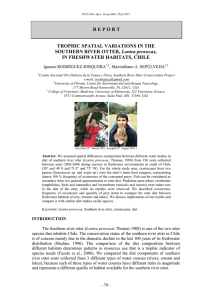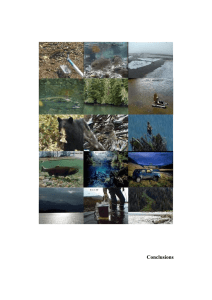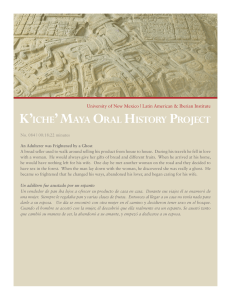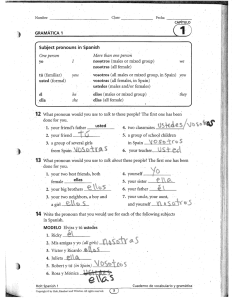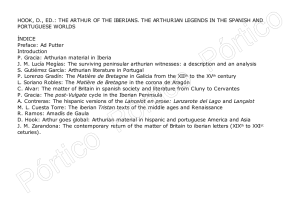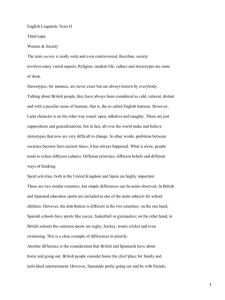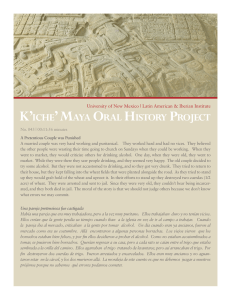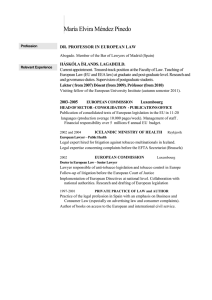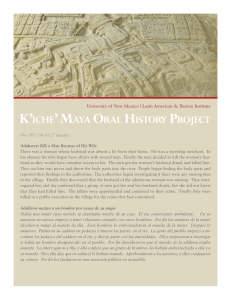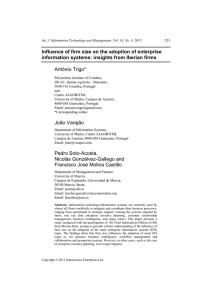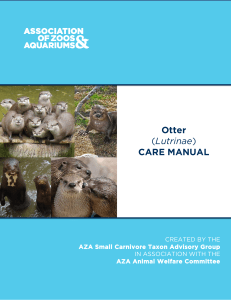EXTERNAL MORPHOMETRY, DEMOGRAPHY AND MORTALITY
Anuncio
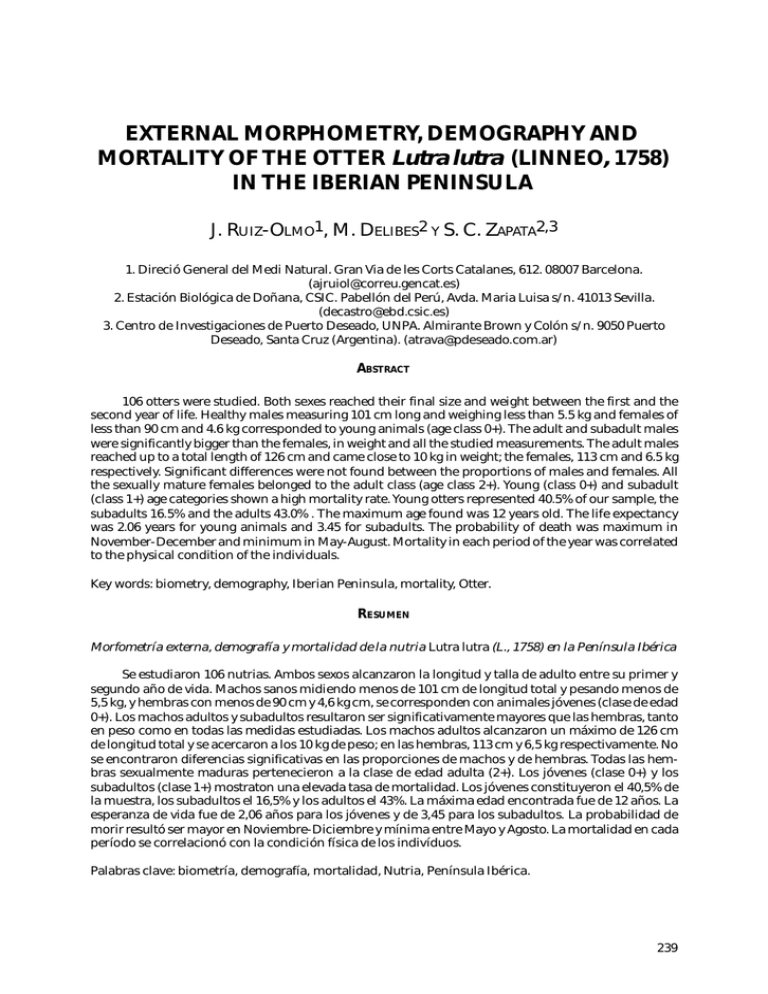
Morphometry and demography of the Otter EXTERNAL MORPHOMETRY, DEMOGRAPHY AND MORTALITY OF THE OTTER Lutra lutra (LINNEO, 1758) IN THE IBERIAN PENINSULA J. RUIZ-OLMO1, M. DELIBES2 Y S. C. ZAPATA2,3 1. Direció General del Medi Natural. Gran Via de les Corts Catalanes, 612. 08007 Barcelona. (ajruiol@correu.gencat.es) 2. Estación Biológica de Doñana, CSIC. Pabellón del Perú, Avda. Maria Luisa s/n. 41013 Sevilla. (decastro@ebd.csic.es) 3. Centro de Investigaciones de Puerto Deseado, UNPA. Almirante Brown y Colón s/n. 9050 Puerto Deseado, Santa Cruz (Argentina). (atrava@pdeseado.com.ar) ABSTRACT 106 otters were studied. Both sexes reached their final size and weight between the first and the second year of life. Healthy males measuring 101 cm long and weighing less than 5.5 kg and females of less than 90 cm and 4.6 kg corresponded to young animals (age class 0+). The adult and subadult males were significantly bigger than the females, in weight and all the studied measurements. The adult males reached up to a total length of 126 cm and came close to 10 kg in weight; the females, 113 cm and 6.5 kg respectively. Significant differences were not found between the proportions of males and females. All the sexually mature females belonged to the adult class (age class 2+). Young (class 0+) and subadult (class 1+) age categories shown a high mortality rate. Young otters represented 40.5% of our sample, the subadults 16.5% and the adults 43.0% . The maximum age found was 12 years old. The life expectancy was 2.06 years for young animals and 3.45 for subadults. The probability of death was maximum in November-December and minimum in May-August. Mortality in each period of the year was correlated to the physical condition of the individuals. Key words: biometry, demography, Iberian Peninsula, mortality, Otter. RESUMEN Morfometría externa, demografía y mortalidad de la nutria Lutra lutra (L., 1758) en la Península Ibérica Se estudiaron 106 nutrias. Ambos sexos alcanzaron la longitud y talla de adulto entre su primer y segundo año de vida. Machos sanos midiendo menos de 101 cm de longitud total y pesando menos de 5,5 kg, y hembras con menos de 90 cm y 4,6 kg cm, se corresponden con animales jóvenes (clase de edad 0+). Los machos adultos y subadultos resultaron ser significativamente mayores que las hembras, tanto en peso como en todas las medidas estudiadas. Los machos adultos alcanzaron un máximo de 126 cm de longitud total y se acercaron a los 10 kg de peso; en las hembras, 113 cm y 6,5 kg respectivamente. No se encontraron diferencias significativas en las proporciones de machos y de hembras. Todas las hembras sexualmente maduras pertenecieron a la clase de edad adulta (2+). Los jóvenes (clase 0+) y los subadultos (clase 1+) mostraton una elevada tasa de mortalidad. Los jóvenes constituyeron el 40,5% de la muestra, los subadultos el 16,5% y los adultos el 43%. La máxima edad encontrada fue de 12 años. La esperanza de vida fue de 2,06 años para los jóvenes y de 3,45 para los subadultos. La probabilidad de morir resultó ser mayor en Noviembre-Diciembre y mínima entre Mayo y Agosto. La mortalidad en cada período se correlacionó con la condición física de los indivíduos. Palabras clave: biometría, demografía, mortalidad, Nutria, Península Ibérica. 239 Galemys 10 (nº especial), 1998 INTRODUCTION The Eurasian otter (Lutra lutra L., 1758) declined significantly throughout Europe since the decade of the 50s (Mason y Macdonald 1992). In Spain, large populations of the species are still found in the Western half of the country and in certain mountain ranges, while it is scarce or has disappeared from the East and from areas of intensive agriculture or industry (Delibes 1990; Ruiz-Olmo and Delibes 1998). The species is classified as «vulnerable» in the Spanish Red Data Book (Blanco and González 1992). Since 1973, the otter is a strictly protected species. Knowledge about the biometry, biology and demography of the Eurasian otter is still scarce, despite its wide geographical distribution (Harris 1968; Mason and Macdonald 1986; De Silva 1981; Kruuk 1995). Studies concerning biometry hardly give a series of external measurements (Stroganov 1962; Jensen 1964; Fairly 1972; Reuther 1980; Twelves 1982), and only recently more detailed research has been undertaken (Sidorovich 1991; Lynch and O’Sullivan 1992). Also, taxonomic studies on L. lutra based on its biometry are very scarce (van Bree et al., 1966). On the other hand, it is interesting to relate body parameters (such as weight and total length) with characteristics of the ecology, mortality and conservation of the species (Kruuk et al. 1987; Kruuk and Conroy 1991; Kruuk 1995). In the same way it is important to know its growth patterns (Stephens 1957), in order to be able to discriminate between age classes «in vivo», such as it has been carried out for the marine otter (Enhydra lutris) (Garshelis 1984). Demographic aspects of the populations («sex-ratio», «age-ratio», life expectancy, etc.) have been approached by Stubbe (1969), Heggberget (1991), Kruuk and Conroy (1991), Kruuk et al. (1997), Ansorge et al. (1997) and Gorman et al. (1998), but there is not information about otter populations in Mediterranean habitats. The references to causes of mortality are more common (see summary in Jiménez and Delibes 1990, and Green 1991), although they refer exclusively to mortality detected directly by humans (Heggberget 1991). Few studies look into the subject from a dynamic point of view, relating it to ecological processes (Kruuk et al. 1987 and 1991; Kruuk and Conroy 1991). The aims of the present study are to characterize morphometrically Iberian otters, to contribute to the knowledgement on their demography and to analyse the rates and causes of mortality. 240 Morphometry and demography of the Otter MATERIAL AND METHODS Since 1969 to 1996 we studied 106 immobilized or dead Iberian otters. Dead otters were collected throughout Spain and in some cases are deposited in scientific collections (National Museum of Natural Sciences -CSIC- in Madrid, the Barcelona Zoological Museum, the Biological Station of Doñana -CSIC- in Sevilla and the Pyrenean Institute of Ecology -CSIC- in Jaca). Live animals were captured for studies or conservation projects. The weight (W) and the external body measurements (total length, L; head-body length, HB; tail length excluding terminal hairs, T; hind foot length, BF; ear length, E) have been taken from each individual. We recorded also the sex, the cause and date of death (when known; necropsies and the necessary histological analyses were carried out). Dead individuals which had presumably lost weight after dying, or gain weight (water or earth in body or skin, metals, ...), have not been included. Age was estimated in each animal by counting cement «annuli» in the teeth, following the methodology described by Klevezal and Kleinenberg (1967) and Grue and Jensen (1979) and used on otters by Stephenson (1977), Heggberget (1984, 1991), Garshelis (1984), Kruuk and Conroy (1991), Ansorge et al. (1997) and Gorman et al. (1998). According to these authors, in L. lutra one layer of cementum (an «annulus») is generated per year and the first growth line is deposited at the end of the first year of life. Three age classes have been defined: young (0+; without «annuli» in the teeth; it is assumed that they are individuals in their first year of life), subadults (1+; with one «annulus»; individuals between their first and second year of life) and adults (2+; with two or more «annuli»; individuals two or more years old). For each individual, an index of corporal condition (K) has also been calculated, relating weight (W) in kg to total length (L) in metres (Kruuk et al. 1987), taking into consideration the corrected functions of Ruiz-Olmo (1995) for the Iberian otters: K (males)=W / 5.91 L2.76; r=0.97; n=18 K (females)=W / 5.36 L2.61; r=0.99; n=15 When K<1, the individual is thinner (in worse condition) than expected, judging from the sample model, while the values of K>1 correspond to animals in better condition than the aforementioned. We tried to distinguish between individuals whose death could be related to diseases or physical problems (i.e. killed by dogs, collected after the mother’s death, found dead with no wounds, sickly and shoot) from those dead or captured apparently by accident or for random reasons (i.e. run over by a car, recently drowned in fish traps etc), 241 Galemys 10 (nº especial), 1998 following Kruuk et al. (1987), Mason and Madsen (1990) and Kruuk and Conroy (1991), although the fact that some otters died from gun shots or in snares and traps does not allow us to use the classification of violent - non-violent proposed by these authors. R ESULTS Physical Characteristics Individuals of the same sex of the age classes 1+ and 2+ cannot be differentiated in their total length (L) (Table 1; males: t=0.745; dF=21; p=0.45; females: t=1.785; dF=20; p=0.09) and weight (W ) (males: t=0.16; dF=15; p=0.87; females: t=0.793; dF=20; p=0.46). This indicates that both sexes reach their final size after their first year of life (subadults). Hence, it is not possible to distinguish from their measures the adult from the subadult individuals. Healthy males weighing less than 5.5 kg and females weighing less than 4.6 kg corresponded to young animals (class 0+). However, given that weight is conditioned by the physical condition of the animal, using the total length (L) to discriminate is recommended. In this way, males measuring less than 101.0 cm and females less than 90.0 cm were young animals in their first year of life (class 0+). Even so, one adult male measured an exceptionally low 98.0 cm of total length, due to his very short tail (33 cm) possibly shortened accidentally. In such cases, it is useful to know that the head-body length (HB) was usualy under 60.0 cm for young males and is under 57.0 cm for young females. For otters belonging to 1+ and 2+ age classes, males were significantly bigger than females in weight and in all measures (except BF in the individuals from class 1+ and E in both) (Table 1). On average, the males from age 2+ were 7.8% longer and 36.7 % heavier than the females. «Sex-ratio» More males than females have been found, but the difference was not significant when considering all the individuals (X2=2.09, 1 dF; p=0.09; 54 males and 40 females), only young animals (X2=0.46; 1 dF; p 0 0.82; 16 males and 11 females), only subadults (X2=0.88; 1 dF; p=0.88; 8 males and 6 females), or only adults (X2=0.13; 1 dF; p=0.89; 21 males and 18 females). Demography All the sexually mature females belonged to the 2+ class. At least 12 of the 18 females of this age were breeding or had bred on some occasion (presence of 242 Morphometry and demography of the Otter foetuses, placental scars or signs of lactation). The survival curve of the species (Figuare 1) demonstrated the high mortality in the young age groups (class 0+) and subadults (class 1+). Young otters represented 40.5% of our sample, the subadults 16.5% and the adults 43.0% (n=79). The maximum ages reported were 12 years for a male and 10 years for a female. Life expectancy for a young animal was 2.12 years in males and 2.23 years in females (2.06 as a whole, including males, females and undetermined); that of subadults was 3.48 and 3.58 years respectively (3.45 as a whole), and for adults 4.44 and 4.50 years (4.41 years as a whole). Figure 1. Age structure (% of survivors) of Iberian otters, in comparison to those of Norway (Heggberget 1991), the Shetland Islands (Kruuk and Conroy 1991), Scotland and England-Wales (Gorman et al. 1998) Estructura de edad (% de supervivientes) de las nutrias ibéricas, en comparación con las de Noruega (Heggberget 1991), Islas Shetland (Kruuk and Conroy 1991), Escocia e Inglaterra-Gales (Gorman et al. 1998) Mortality The pattern of otter mortality have shown a certain seasonality (X2=54.54; dF =5; p <0.001), reaching a maximum in November-December (43.2% of the total; n=88) and a minimum in May-June and July-August (with 3.4% and 5.7% respectively) (Figure 2). In this way, 69.3% of our otters died in the five months of the autumn-winter period (November to March). The body condition index (K) of the otters which died due to random causes tended to be significantly higher (X2=9.884; dF=6; p=0.0786) than that of the otters which died through other causes (Figure 3). Furthermore, the mortality in each period of the year was correlated with the physical condition (Figure 4). 243 Galemys 10 (nº especial), 1998 Figure 2. Bimonthly variation of the percentage of collected dead individuals Variación bimensual en el porcentaje de individuos recolectados muertos Figure 3. Comparison between the body condition index (K) of the otters which were dead or captured at random and other causes (i.e. killed by dogs, collected after the mother’s death, found dead with no wounds, sickly, shoot, ...) Comparación entre el índice de condición corporal (K) de las nutrias muertas o capturadas al azar y las muertas por otras causas (e. g. muertas por perros, recogidas tras la muerte de la madre, encontradas muertas sin heridas, enfermedad aparente, disparos....) 244 Morphometry and demography of the Otter Figure 4. Relationship between the average percentage of monthly mortality and (a) the average value of the body condition index and (b) the percentage of individuals with K< 0.8. NOTE: the data has been gathered from those months when there were not sufficient samples to do a separate analysis Relación entre el porcentaje medio de mortalidad mensual y (a) el valor medio del índice de condición corporal y (b) el porcentaje de individuos con K<0,8. Los valores han sido agrupados en aquellos meses en los que no existían muestras suficientes para ser analizadas por separado 245 Galemys 10 (nº especial), 1998 DISCUSSION Our study could be criticized because we considered all of the Iberian otters as belonging to a single population, when environmental conditions are varying across Iberia. Moreover, the carcasses came from over a long period of time, and the causes of death could also affect the sample (Kruuk 1995). All of these problems difficult the demographic analysis and pose limitations to the interpretation of the results (Caughley 1977). However, it is very difficult to obtain enough data from smaller and specific populations. Because of this, almost all of the studies carried out on the demography of L. lutra have approximately the same limitations (Stubbe 1969; Heggberget 1991; Ansorge et al. 1997; Gorman et al. 1998). On the other hand, otters move usually tens of kilometres, or even exceed 100 km when dispersing (Kruuk 1995; Saavedra et al. 1997); in this way, gene flow inside the Iberian Peninsula may be possible untill recent times, and wide local changes in body measurements are not expected. Although few studies deal with the biometry of L.lutra, our results suggest that the Iberian otters are smaller in size than those of central and northern Europe and Asia (Stroganov 1962; Jensen 1964; Fairley 1972; Twelves 1982; Sidorovich 1991). Males in Great Britain and Ireland were on average 3.3 - 11.7% larger than the Spanish ones, and the British females were 1.7% larger. The differences are more evident if attention is paid to weight: the British males weighed on average 2.6 kg more than the Iberian ones (35.3%), the Irish 1.6 kg (21.9%), the Byelorussians 1.1 kg (15.2%) and the Danish 0.8 kg (11.2%); the females in Britain weighed 1.8 kg more than the Iberian ones (33.5%), the Byelorussians 1.4 kg (25.4%) and the Irish and Danish 0.7 kg (13.3%). These results suggest that, in general, the otter responds positively to Bergmann’s Ecographical Rule (Mayr 1954), increasing in size with latitude. However, as different authors have pointed out (Mcnab 1971), this empirical observation does not have explanatory value, as many different factors can justify the differences of size detected. In this way, the Spanish otters could be smaller for: (a) climatic reasons (the Bergmann Rule’s classical explanation); (b) thermoregulation, very important in a species living in semiaquatic environments (related to the above, the otter is under great environmental pressure as is living often in water without a thick layer of fat; Mcnab 1989; Kruuk 1995); (c) metabolic reasons, related to the productivity of the aquatic ecosystems (Mediterranean rivers are productive, which could decrease individual spatial needs, giving adaptive value to individuals of small size; in the same way, however, individuals could be larger in more productive ecosystems); (d) differences in the size of the potencial prey or in its capture ability; 246 Morphometry and demography of the Otter cyprinids are easier to catch than trouts, salmon or pike); and (e) fluctuations in the Mediterranean freshwaters (droughts, floods, etc), which determine the existence of periods of food shortage (this would favour otters of low body mass which had less food needs and greater probabilities of survival in these periods). The small size could be due to several of these reasons occuring simultaneously, and maybe even others.Some of these potential reasons deserve special attention. Ruiz-Olmo and Palazón (1998) have found that the Iberian otter’s prey in Mediterranean rivers tend to be larger on the average (see also Callejo 1988) than those of central and northern Europe (Kruuk 1995); this would go against the expected, since the Iberian otters would need to be bigger in order to catch larger fish. The otter’s large spacial requirements, which can reach up to tens of kilometres (Kruuk 1995), constitute another important aspect. In Mediterranean areas the otter can be exposed to high ecological and thermic variations in its home range throughout the year (Ruiz-Olmo 1995), comparable or even more severe than those of areas of Central and Northern Europe. Another factor to be considered is the temporal variation in food availability (Ruiz-Olmo 1994; Kruuk 1995; Ruiz-Olmo et al. in press). In the Shetland Islands, in the Northern range of its distribution area, the otters are smaller and very similar to the Iberian animals (H. Kruuk personal communication); like Mediterranean otters facing unpredictable estival droughts, spring and autumn floods and winter snow, the Shetland animals are exposed to a cyclic period of annual food shortage. The «sex-ratio» has not significantly differed from 1:1. Heggberget (1991) found significantly more males in the 0+, 1+ and 4+ age classes. SIDOROVICH (1991) found more males hunted and skinned, and more living females in these exploited populations from which the males have been taken. In general, the higher proportion of males in the samples of Carnivores is often explained by its greater vulnerability to trapping (Buskirk and Lindstedt 1989). The age structure (and percentage of survivors in each age class) of the Iberian otters practically does not differ from those found in other studies carried out in Germany, Norway, Byelorussia or mainland Scotland (Fig. 1), where young otters (0+ class) represented 31.7 - 42.0% of the individuals collected (except in the Shetland Islands and England, with 19.5 - 23%), the subadults (class 1) 8.5 - 33% and the adults (class 2+) 14.0 - 43% (Stubbe 1969; Heggberget 1991; Kruuk and Conroy 1991; Sidorovich 1991; Kruuk 1995; Ansorge et al. 1997; Gorman et al. 1998). These ratios can vary in the same population throughout time (Kruuk et al. 1997). The maximum longevity usually coincided with 12 years in the majority of the studies, the Iberian Peninsula included, with a maximum of 16 years recorded in the British Isles (Gorman et al. 1998). 247 Galemys 10 (nº especial), 1998 As a consequence, life expectancy was also similar to those outlined by different authors. The results obtained in the current study show that a female which reaches the 1+ age class (subadult) has a life expectancy of 3.0-3.6 years, reaching maturity during the second year (in agreement with Corbet and Harris 1991, and Kruuk and Conroy 1991). This leaves room for a theoretical average (if breeds every year) of 1-2 litters per female throughout life. Considering that the average size of litters of the Iberian otters from continental waters oscilates between 1.7 and 2.9 young (Ruiz-Olmo 1993 and 1998; Beja 1995), this represents 1.7-5.8 young on average per female throughout life. According to the data obtained here, the oldest females (in general, 10 - 12 years old) can reach a theoretical maximum of 7-9 litters, which would represent 11.926.1 young throughout their lives. As in the Shetland Islands and Norway (Kruuk and Conroy 1991; Heggberget 1993; Kruuk 1995), mortality in the Iberian Peninsula was seasonal, with a maximum in autumn-winter; as in precedent areas, it could be possibly due to the lower availability of ectothermic prey complimentary to fish (aquatic insects, crayfish, amphibians, water snakes) at this time of the year (Ruiz-Olmo and Palazón 1998). However, in Denmark and Great Britain a seasonal variation in mortality was not found (Mason and Madsen 1990). As in the study by Kruuk and Conroy (1991) the otters with a low body condition index (proportionally thin) had a significantly greater probability of dying than the rest. This suggests once again that individual ability to obtaining food influences the probability of survival and, therefore, the dynamics of the population, making the otter a food limited species (Kruuk et al. 1991; Ruiz-Olmo 1994 and in press b; Kruuk 1995; Kruuk and Carss 1996; Gorman et al. 1998; Ruiz-Olmo et al. in press). The results presented are of importance for the conservation and management of otter populations in the Iberian Peninsula. AKNOWLEDGEMENTS The authors would like to express their gratitude to those people who have colaborated in obtaining the material for this study, especially Dr. Antonio Callejo (Lugo), Guillermo Palomero (Santander), Juan Jimenez (Valencia), Jordi i Lluis Bonet (Lleida), Dr. Carlos Nores (Oviedo), and Deli Saavedra (Parc Natural dels Aiguamolls de L’Empordà). Likewise, to «Chema» López-Martín and Santiago Palazón for their colaboration in the compilation of material and for carrying out the necropsies. Dr. Alejandro Travaini revised a firsts draft of the manuscript. Emma O’Dowd translated the text. REFERENCES ANSORGE, H., R. SCHIOPKE AND O. ZINPE (1997). Population structure of the otter, Lutra lutra, Parameters and model for a Central European region. Z. Säugetierk., 62: 143-151. BEJA, P. R. (1995). Patterns of availability and use of resources by otters (Lutra lutra L.) in 248 Morphometry and demography of the Otter Southwest Portugal. Ph.D. Thesis. University of Aberdeen. BLANCO, J. C. AND L. M. GONZALEZ (1992). Libro rojo de los vertebrados de España. Colección técnica. Ministerio de Agricultura, Pesca y alimentación, ICONA. Madrid, 714 pp. BUSKIRK, S. W. AND S. L. LINDSTEDT (1989). Sex biases in trapped samples of Mustelidae. J. Mammal., 70 (1): 88-97. CALLEJO, A. (1988). Le choix des proies par la loutre (Lutra lutra) dans le nord-ouest de l’Espagne, en rapport avec les facteurs de l’environement. Mammalia, 52(1): 11-20. CAUGHLEY (1977). Analysis of vertebrae populations. Wiley. London. CORBET, G. B. AND S. HARRIS (1991). The handbook of British Mamals. Blackwell Scientific. Oxford. DE SILVA, P. K. (1989). Aspects of Behaviour and Ecology of Old World Otters. A review. In: Proceedings V. Int. Otter Coll. Hankensbüttel 1989 (C. Reuther and R. Röechter, Ed.). Habitat, 6:95-106. DELIBES , M. (1990). La nutria (Lutra lutra) en España. Serie Tècnica. ICONA, Madrid. 198 pp. FAIRLEY, J. S. (1972). Food of otters (Lutra lutra) from Co. Galway, Ireland and notes on aspects on their biology. J. Zool., London, 166: 469-474. GARSHELIS, D. L. (1984). Age estimation of living Sea Otters. J. Wildl. Manage., 48(2): 456-463. GORMAN, M. L., H. KRUUK, C. JONES, G. MCLAREN AND J. W. H. CONROY (1998). The demography of European otters Lutra lutra. In: Behavour and Ecology of Riparian Mammals (N. Dunstone and M.L. Gorman, Eds.), Cambridge Univ. Press, Cambridge, pp. 107-118. GREEN, R. (1991). The impact of hunting, poaching and accidents on otter survival and measures to protect individual animals. In: Proceddings V. Int. Otter Coll. Hankensbüttel 1989 (C. Reuther and R. Röechter, Ed.). Habitat, 6: 171-190. GRUE, H. AND B. JENSEN (1979). Review of the formation of incremental lines in tooth cementum of terrestrial mammals. Dan. Rev. Game Biol., 11. HARRIS, C. J. (1968). Otters. A study of the recent Lutrinae. Weidenfeld and Nicolson, London, 397 pp. HEGGBERGET, T. M. (1984). Age determination in the European otter Lutra lutra lutra. Z.f. Säugetierkunde Bd., 49: 199-305. HEGGBERGET , T. M. (1991). Sex and Age distribution in Eurasian Otters (Lutra lutra) killed by Human Activity. In: Proceedings V. Int. Otter Coll. Hankensbüttel 1989 (C. Reuther and R. Röechter, Ed.). Habitat, 6:123-125. HEGGBERGET , T. M. (1993). Reproductive strategy and feeding ecology of the Eurasian Otter Lutra lutra. Dr. Sc. Thesis. University of Trondheim. JENSEN, A. (1964). Odderen i Danmark. Danske Vildtundersogelser, 11: 1-48. JIMENEZ, J. AND M. DELIBES (1990). Causas de la rarificación. In: La nutria (Lutra lutra) en España (M. Delibes, ed.), Serie Tècnica. ICONA, Madrid, pp. 169-177. KLEVEZAL, G. A. AND S. E. KLEINENBERG (1967). Age estimation of mammals from annual layers in teeth and bones. Translations 1969. Jerusalem: Israel Program for Scientific Translations, 166 pp. KRUUK, H. (1995). Wild Otters. Predation and Populations. Oxford University Press. Oxford. 304 pp. KRUUK, H. AND D. N. CARSS (1996). Costs and benefits of fishing by a semi-aquatic carnivore, the otter Lutra lutra. In: Aquatic Predators and their Prey (S.P.R. Greestreeet and M. L. Tasker, eds.), Fishing News Books, Cambridge, pp. 10-16. KRUUK, H. AND J. W. H. CONROY (1991). Mortality of otters (Lutra lutra) in Shetland. J. Appl. Ecol., 28: 83-94. 249 Galemys 10 (nº especial), 1998 KRUUK, H., J. W. H. CONROY AND A. MOORHOUSE (1987). Seasonal Reproduction, Mortality and Food of Otters (Lutra lutra L.) in Shetland. Symp. Zool. Soc. Lond., 58: 263-278. KRUUK, H., J. W. H. CONROY AND A. MOORHOUSE (1991). Recruitement to a population of Otters (Lutra lutra) in Shetland, in relation to Fish abundance. J. Appl. Ecol., 28:95-101. KRUUK, H., C. JONES, G. W. MCCLAREN, M. L. GORMAN AND J. W. H. CONROY (1997). Changes in age composition in populations of the Eurasian otter Lutra lutra in Scotland. J. Zool., 243: 853-857. LYNCH, J. M. AND W. H. O’SULLIVAN (1992). Cranial form and sexual dimorphism in the Irish otter Lutra lutra L. Biology and Environment, 93B (2): 111-112. MACDONALD, S. M. AND C.F. MASON (1992). Status and conservation needs of the otter (Lutra lutra) in the Western Palearctic. Council of Europe. 66 pp. MASON, C. F. AND S. M. MACDONALD (1986). Otters. Ecology and Conservation. Cambridge Univ. Press. 236 pp. MASON, C. F. AND A. B. MADSEN (1990). Mortality and condition in otters Lutra lutra from Denmark and Great Britain. Natura Jutl., 22(14): 217-220. MAYR, E. (1954). Cange of Genetic environment and Evolution. In: Evolution as a Process. Allen and Unwin. London. MCNAB, B. K. (1971). On the ecological sginificance of Bergmann’s rule. Ecology, 52: 845-854. MCNAB, B. K. (1989). Basal Rate Metabolism, Body Size, and Food Habits in the Order Carnivora. In: Carnivore Behaviour, Ecology, and Evolution (J.L. Gittleman, ed.), Chapman and Hall, London, pp. 335-354. R EUTHER, C. (1980). Der Fischotter, Lutra lutra L. in Niedersachsen. Nat. Landsch. Niedersachsen, 11:1-182. RUIZ-OLMO, J. (1993). Reproducción y observación de grupos de nutria (Lutra lutra L.) en el Norte de España. Misc. Zool., 17: 225-229. RUIZ-OLMO, J. (1994). Influence of food availability on otter distribution and abundance. In: Seminar on the Conservation of the European Otter (Lutra lutra), Leeuvarden, the Netherlands, 7-11 June 1994, pp. 114-116. RUIZ-OLMO, J. (1995). Estudio bionómico sobre la nutria (Lutra lutra L., 1758) en aguas continentales de la Península Ibérica. Ph.D. Thesis. University of Barcelona. RUIZ-OLMO, J. (1998). Influence of altitude on the distribution, abundance and ecology of the otter (Lutra lutra). In: Behavour and Ecology of Riparian Mammals (N. Dunstone y M.L. Gorman, Eds.), Cambridge Univ. Press, Cambridge, pp. 159-176. RUIZ-OLMO, J. AND M. DELIBES (1998). La nutria en España ante el horizonte del año 2000. SECEM, Málaga. RUIZ-OLMO, J., J. M. LÓPEZ-MARTÍN AND S. PALAZÓN (in press). Influence of fish availability on the structure of otter (Lutra lutra) populations in Iberian Mediterranean habitats. J. Appl. Ecol. RUIZ-OLMO, J. AND S. PALAZÓN (1998). The diet of the otter (Lutra lutra) in the Mediterranean freshwater habitats. J. Wildl. Research., 2(2): 171-181. SAVEDRA, D., J. RUIZ-OLMO AND J. JIMÉNEZ (1997). Áreas de campeo y relaciones sociales de la nutria (Lutra lutra L., 1758) en aguas continentales del NE de la Península Ibérica. In: I Jornadas Ibericas sobre la nutria, Castelló d’Empuries (Girona), 5-7 Diciembre 1997, pp. 112. SIDOROVICH , V. E. (1991). Structure, reproductive status and dynamics of the otter population in Byelorussia. Acta Theriol., 36 (1-2):153-161. 250 Morphometry and demography of the Otter STEPHENS, M. (1957). The Natural History of the otter. Report to the Otter Com., UFAW, London. STEPHENSON, A. B. (1977). Age determination and morfological variation of Ontario Otters. Can J. Zool., 55: 1577-1583. STROGANOV, S. V. (1962). Carnivorous Mammals of Siberia. Traducido Israel Program, Jerusalem, 522 pp. STUBBE, M. (1969). Zür Biologie und zum Schutz des Fischotters Lutra lutra (L.). Arch. Naturschutz Landschaftsforsch., 9: 315-324. TWELVES, J. (1982). Otter (Lutra lutra) mortalities in lobster creels. Notes from the Mammal Soc., 47: 585-590. VAN BREE, P. J. H., B. JENSEN AND L. J. K. KLEIJN (1966). Skull dimensions and the length/weight relation of the baculum as age indications in the common otter (Lutra lutra). Dan. Rev. Game Biol., 4: 97-104. 251
